中考英语全国通用版二轮专项复习 句子种类(共41张PPT)
文档属性
| 名称 | 中考英语全国通用版二轮专项复习 句子种类(共41张PPT) | 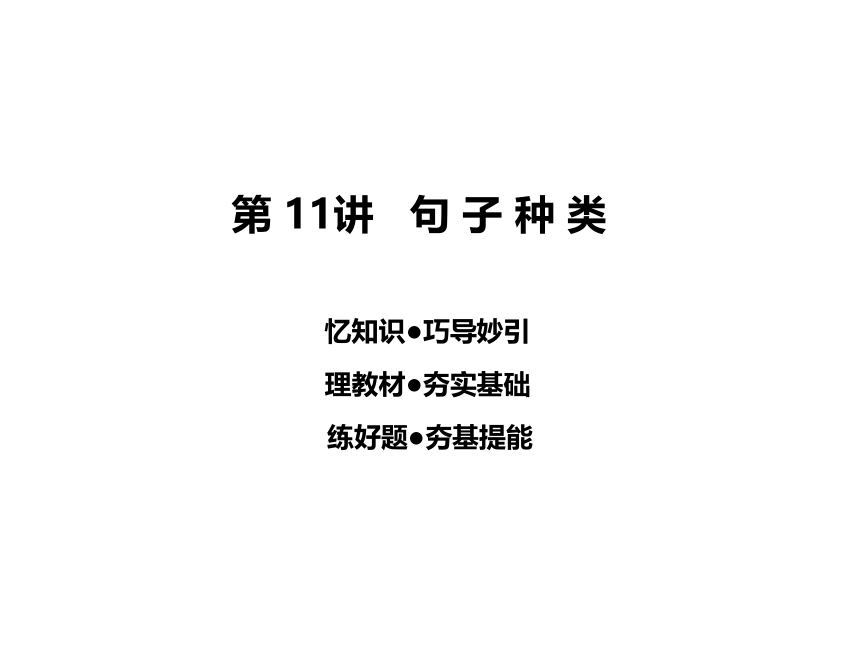 | |
| 格式 | pptx | ||
| 文件大小 | 779.2KB | ||
| 资源类型 | 教案 | ||
| 版本资源 | 通用版 | ||
| 科目 | 英语 | ||
| 更新时间 | 2023-06-20 16:03:15 | ||
图片预览

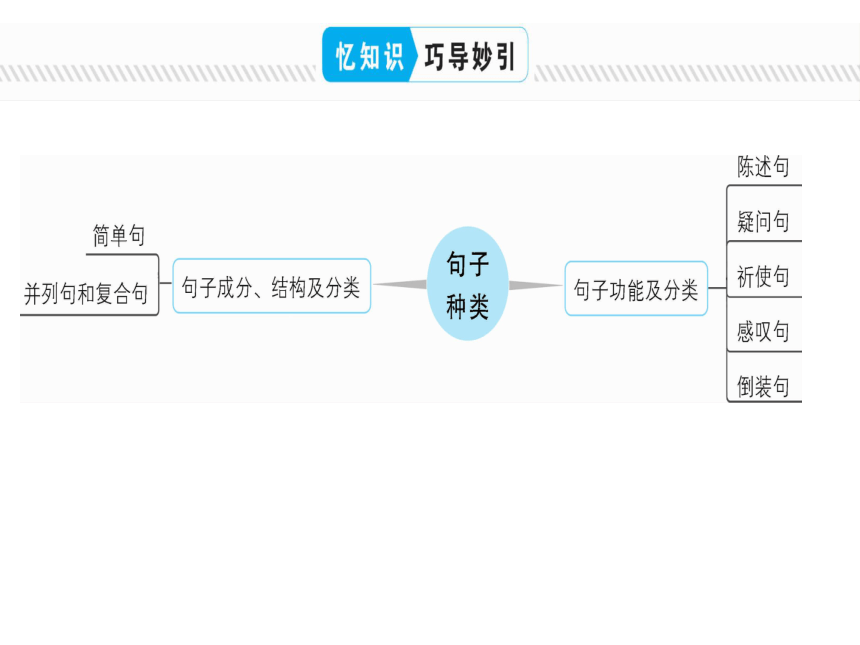

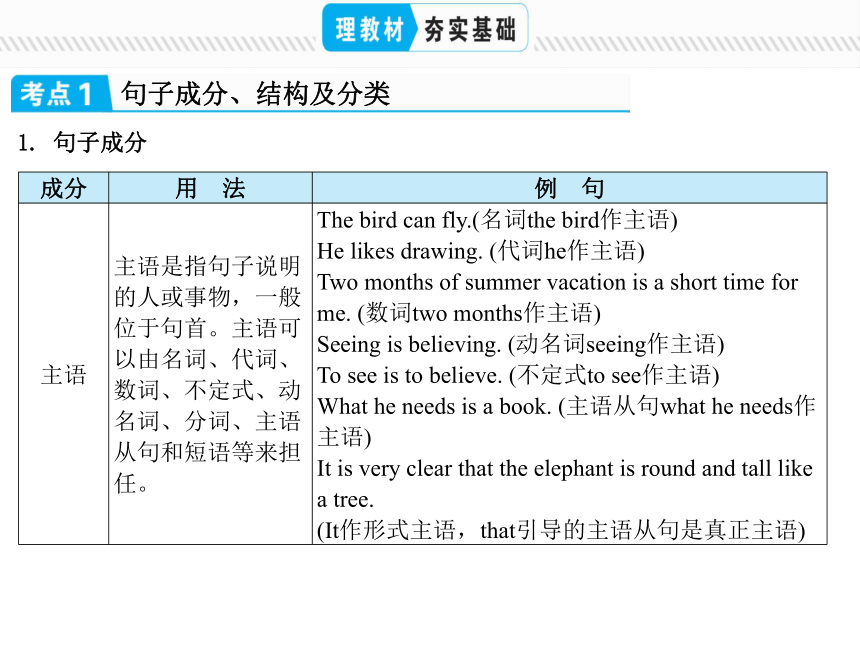

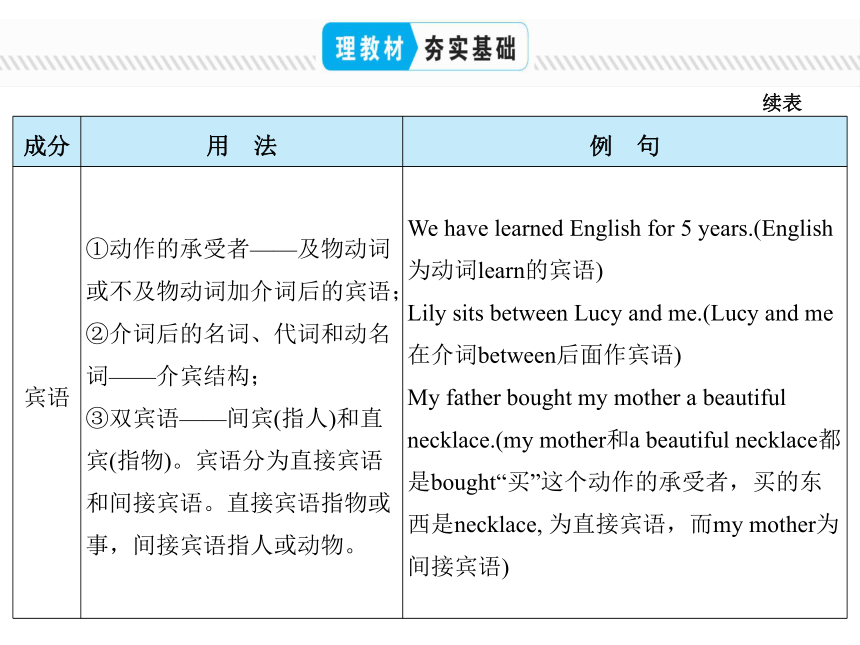
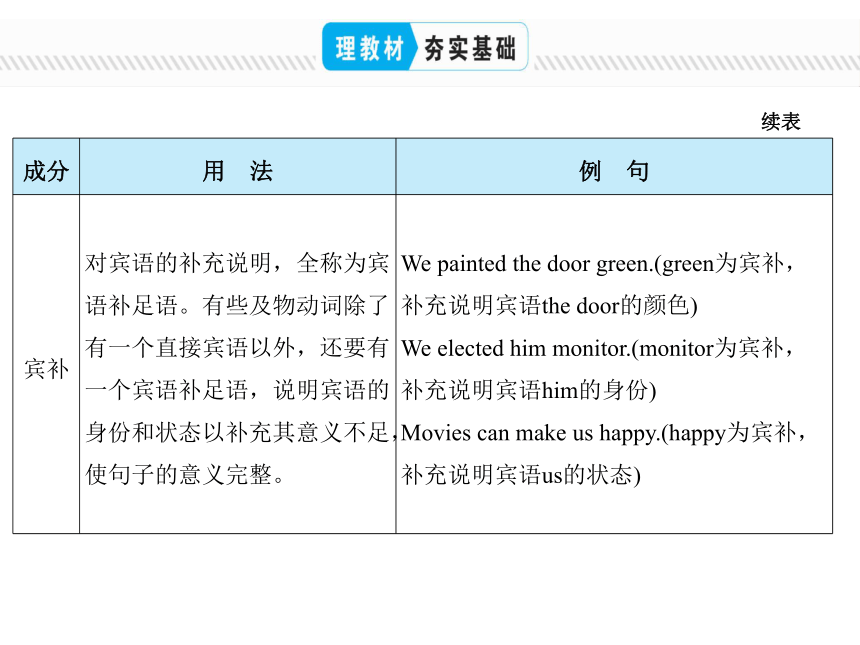
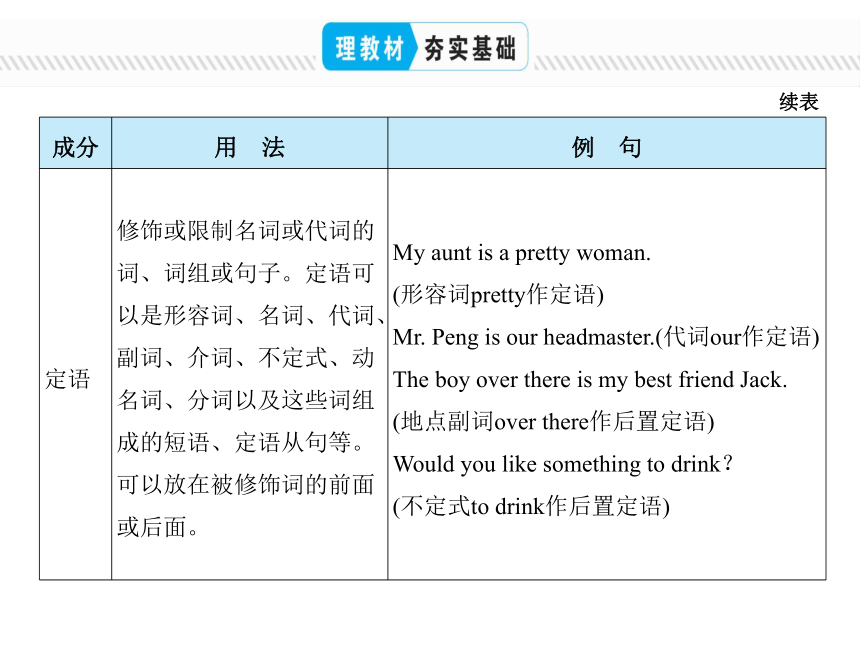
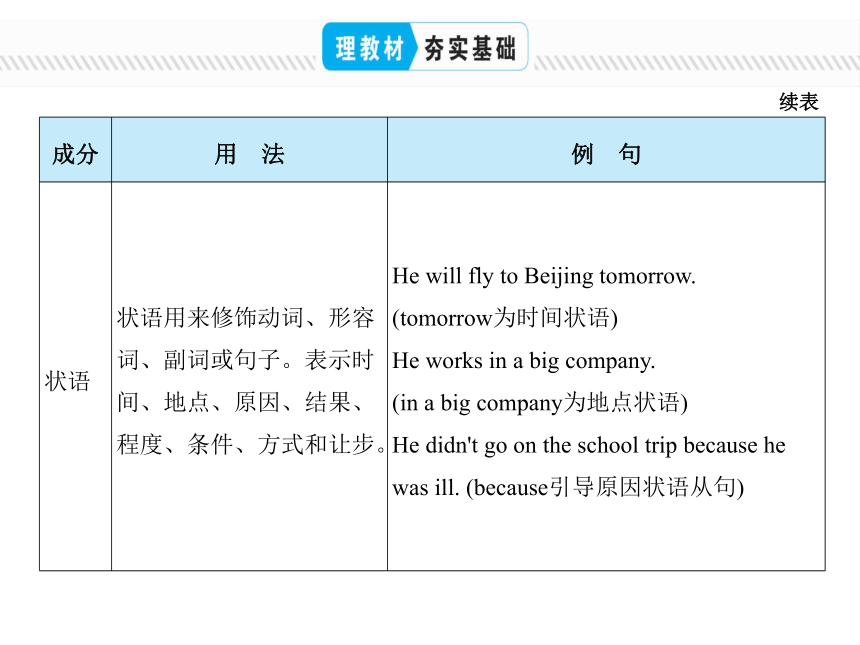
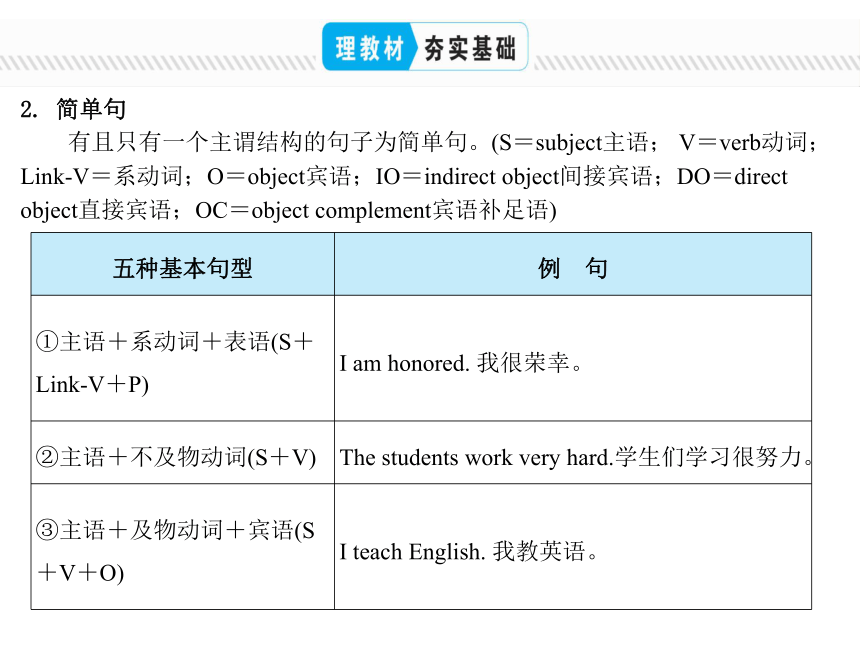
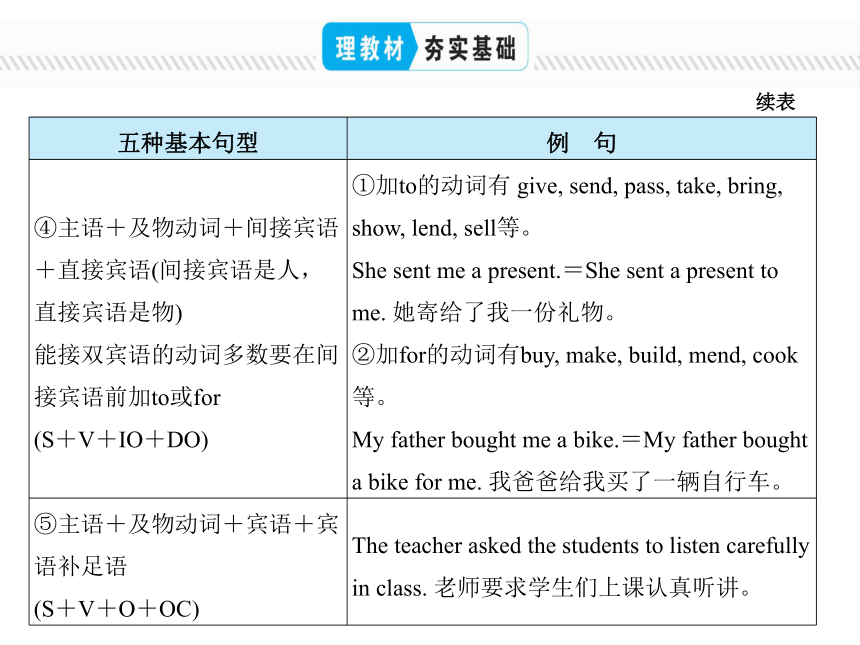
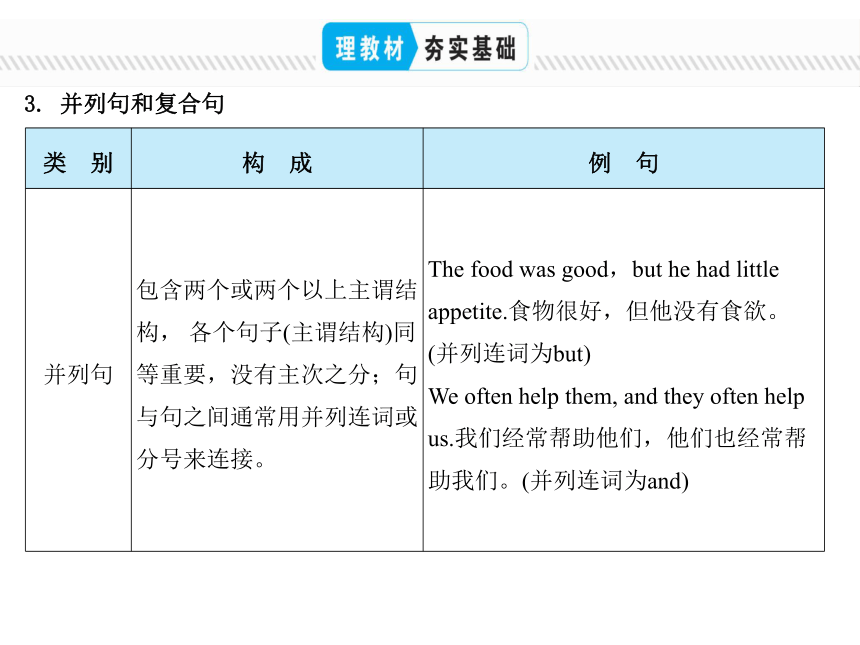
文档简介
(共41张PPT)
第 11讲 句 子 种 类
忆知识●巧导妙引
理教材●夯实基础
练好题●夯基提能
句子是由不同的单词按照一定的语法规则组合在一起,能够表达一个完整意思的结构。句子按结构和使用目的可分为不同的类型。
按照句子成分和结构分类,英语中最小的句子就是简单句(只包含一个主谓结构),其次是并列句(两个或两个以上并列的主谓结构)和复合句(也就是主从复合句,包含一个主句和一个或几个从句)。按照句子的功能分类,可以分为陈述句(肯定和否定),疑问句,祈使句和感叹句。
句子成分、结构及分类
1. 句子成分
成分 用 法 例 句
主语 主语是指句子说明的人或事物,一般位于句首。主语可以由名词、代词、数词、不定式、动名词、分词、主语从句和短语等来担任。 The bird can fly.(名词the bird作主语)
He likes drawing. (代词he作主语)
Two months of summer vacation is a short time for me. (数词two months作主语)
Seeing is believing. (动名词seeing作主语)
To see is to believe. (不定式to see作主语)
What he needs is a book. (主语从句what he needs作主语)
It is very clear that the elephant is round and tall like a tree.
(It作形式主语,that引导的主语从句是真正主语)
续表
成分 用 法 例 句
谓语 谓语说明主语的动作、状态和特征,一般紧跟在主语后面。由动词或动词词组组成,在不同的时态下有不同的形式,动词前面还可以加上情态动词或助动词。 We are excited at the news.(谓语动词为be动词,表示主语的状态)
He went to Beijing yesterday.(went是谓语动词,为go的一般过去式,表示主语的动作)
He can sing very well.他能唱歌唱得很好。
(谓语动词为can sing, sing前面加上情态动词can)
Peter didn't go to school yesterday.(谓语动词为didn't go, go前面加上助动词didn't, 帮助表达否定意义)
表语 用在“主系表”的句子结构中,为系动词之后的成分,表示主语的身份,性质、状态和特征。 Mrs. Green is a teacher.(a teacher为表语,表明主语的身份)
The window is broken.(broken为表语,表明主语的状态)
成分 用 法 例 句
宾语 ①动作的承受者——及物动词或不及物动词加介词后的宾语; ②介词后的名词、代词和动名词——介宾结构; ③双宾语——间宾(指人)和直宾(指物)。宾语分为直接宾语和间接宾语。直接宾语指物或事,间接宾语指人或动物。 We have learned English for 5 years.(English为动词learn的宾语)
Lily sits between Lucy and me.(Lucy and me在介词between后面作宾语)
My father bought my mother a beautiful necklace.(my mother和a beautiful necklace都是bought“买”这个动作的承受者,买的东西是necklace, 为直接宾语,而my mother为间接宾语)
续表
成分 用 法 例 句
宾补 对宾语的补充说明,全称为宾语补足语。有些及物动词除了有一个直接宾语以外,还要有一个宾语补足语,说明宾语的身份和状态以补充其意义不足,使句子的意义完整。 We painted the door green.(green为宾补,补充说明宾语the door的颜色)
We elected him monitor.(monitor为宾补,补充说明宾语him的身份)
Movies can make us happy.(happy为宾补,补充说明宾语us的状态)
续表
续表
成分 用 法 例 句
定语 修饰或限制名词或代词的词、词组或句子。定语可以是形容词、名词、代词、副词、介词、不定式、动名词、分词以及这些词组成的短语、定语从句等。可以放在被修饰词的前面或后面。 My aunt is a pretty woman.
(形容词pretty作定语)
Mr. Peng is our headmaster.(代词our作定语)
The boy over there is my best friend Jack.
(地点副词over there作后置定语)
Would you like something to drink?
(不定式to drink作后置定语)
续表
成分 用 法 例 句
状语 状语用来修饰动词、形容词、副词或句子。表示时间、地点、原因、结果、程度、条件、方式和让步。 He will fly to Beijing tomorrow.
(tomorrow为时间状语)
He works in a big company.
(in a big company为地点状语)
He didn't go on the school trip because he was ill. (because引导原因状语从句)
2. 简单句
有且只有一个主谓结构的句子为简单句。(S=subject主语; V=verb动词;Link V=系动词;O=object宾语;IO=indirect object间接宾语;DO=direct object直接宾语;OC=object complement宾语补足语)
五种基本句型 例 句
①主语+系动词+表语(S+Link V+P) I am honored. 我很荣幸。
②主语+不及物动词(S+V) The students work very hard.学生们学习很努力。
③主语+及物动词+宾语(S+V+O) I teach English. 我教英语。
五种基本句型 例 句
④主语+及物动词+间接宾语+直接宾语(间接宾语是人,直接宾语是物) 能接双宾语的动词多数要在间接宾语前加to或for (S+V+IO+DO) ①加to的动词有 give, send, pass, take, bring, show, lend, sell等。
She sent me a present.=She sent a present to me. 她寄给了我一份礼物。
②加for的动词有buy, make, build, mend, cook等。
My father bought me a bike.=My father bought a bike for me. 我爸爸给我买了一辆自行车。
⑤主语+及物动词+宾语+宾语补足语 (S+V+O+OC) The teacher asked the students to listen carefully in class. 老师要求学生们上课认真听讲。
续表
3. 并列句和复合句
类 别 构 成 例 句
并列句 包含两个或两个以上主谓结构, 各个句子(主谓结构)同等重要,没有主次之分;句与句之间通常用并列连词或分号来连接。 The food was good,but he had little appetite.食物很好,但他没有食欲。(并列连词为but)
We often help them, and they often help us.我们经常帮助他们,他们也经常帮助我们。(并列连词为and)
类 别 构 成 例 句
复合句 包含一个主句和一个或几个从句,句子中有且只有一个主句,其余的句子都是从句(从属于主句,充当主句的某个句子成分,为主句服务)。 The film had begun when we got to the cinema.当我们到电影院的时候,电影已经开始了。(when引导时间状语从句)
Can you tell me where he lives?你能告诉我他住在哪里吗?(where引导宾语从句)
续表
句子功能及分类
1. 按功能分类
类 别 功 能 例 句
陈述句 说明一个事实或陈述一种看法 Light travels faster than sound.
光比声音传播得快。
The film is rather boring.
这部电影非常无聊。
疑问句 一般疑问句 提出问题 Can you finish the work on time?
你能准时完成工作吗?
特殊疑问句 Where do you live?你住在哪里?
选择疑问句 What do you want, tea or coffee?
你想要什么,茶还是咖啡?
反意疑问句 He doesn't know her, does he?
他不认识她,是吗?
类 别 功 能 例 句
祈使句 提出请求、建议或发出命令 Sit down, please.请坐下。
Don't be nervous!别紧张!
感叹句 表示说话人惊奇、喜悦、愤怒等情绪 What good news it is!多好的消息啊!
续表
2. 陈述句
陈述句:是指叙述或说明事实的具有陈述语调的句子。陈述句分为肯定句和否定句。
肯定句变否定句的方法:
肯定形式 否定形式 例 句
谓语动词是be动词 在be动词后加not We are children.→We are not children.
谓语动词只有实义动词 根据句子的时态、人称,在动词前加doesn't, don't或didn't,同时还原动词 Jenny passed the exam.→Jenny didn't pass the exam.
谓语动词含有情态动词、助动词(如will, has/have) 在情态动词或助动词(如will, has/have)后加not He can play the piano.→He can't play the piano.
肯定形式 否定形式 例 句
句中有不定代词everybody、everything、all、both、some或频率副词always等 变为no, never, none, neither, nothing, nobody等表否定意义的单词 Everybody is in the music hall.→Nobody is in the music hall.
以think, believe, suppose, feel, expect等构成的宾语从句 形式上否定主句,意义上否定宾语从句,即将宾语从句中的否定not移到前面主句的动词上,成为“否定前移”,但是翻译时否定要回到宾语从句中 I think he is an honest boy.→I don't think he is an honest boy.我认为他不是个诚实的男孩。
续表
3. 疑问句
类 别 用 法 例 句
一般 疑问句 是用yes或no来回答的句子。一般由be动词、助动词或情态动词开头。 —Is he a student
—Yes, he is. / No, he isn't.
否定疑问句通常以“be动词/情态动词/助动词+not”的缩写形式开头,表示表达某种看法或者惊讶、进行确认等。其答语形式和汉语表达习惯不同,回答yes或no与事实相符。 —Isn't the boy very clever
这个男孩难道不聪明吗?
—Yes, he is. 不,他很聪明。
—No, he isn't. 是的,他不是很聪明。
类 别 用 法 例 句
特殊 疑问句 由特殊疑问词或词组引导的疑问句,针对某个特定的信息点进行提问。 —Where do you live
—I live on Center Street.
常见的特殊疑问词有:what(什么), which(哪一个), who(谁,作主语), whom(谁,作宾语), whose(谁的), when(什么时候), where(在哪里), why(为什么), how(怎么样), how many(多少,接可数名词复数), how much(多少,接不可数名词), how far(多远,问距离), how long(多久/多长时间,问时间;多长,问具体长度), how soon (多久以后,用于将来时), how often (多久一次,问频率) 续表
续表
类 别 用 法 例 句
选择 疑问句 结构:①“一般疑问句+or+另一个备选对象”;②“特殊疑问句,A选项+or+B选项”(选项可以是两个或两个以上); 回答:不能回答yes或no。只能从两个或多个选择中选择其一进行回答;或者用不定代词回答:all(三者或三者以上都), both(二者都), either(二者中任意之一), neither (二者都不), none(三者或三者以上都不)。 —Do you want tea or coffee?
你想喝茶还是咖啡?
—Tea, please.请给我茶。
Which would you like best, English, Chinese or Math?
英语,语文和数学这三门科目,你最喜欢哪一门?(备选对象为三者)
续表
类 别 用 法 例 句
反意 疑问句 反意疑问句的构成: 陈述句+附加疑问句。 基本形式:附加疑问句由be动词/助动词/情态动词的肯定/否定式+主语构成,其否定式必须缩写,主语只能用代词。 “陈述句+附加疑问句”遵循“前否后肯或前肯后否”,前句和后句的人称和时态一致。 She is a policewoman, isn't she
她是一名警察,不是吗?
He can't drive a car, can he
他不会开车,是吗?
He slept for 9 hours yesterday, didn't he 他昨天睡了9个小时,不是吗?
He won't go to the park, will he
他不会去公园,是吗?
续表
类 别 用 法 例 句
反意疑问句 特殊形式: ①当陈述句中含有表示否定意义的代词或形容词,如nothing, none, no one, nobody, neither, few, little等,或含有表示否定意义的副词never, hardly, seldom时,附加疑问句要用肯定式。 ②祈使句的反意疑问句的附加疑问句部分用will you/won't you。 ③陈述句部分为Let us…时,附加疑问句用will you; 陈述句部分为Let's…时,附加疑问句用 shall we。 ④陈述部分的谓语是used to时,附加疑问句部分用“didn't+主语”或“usedn't+主语”。 ①Linda has never been to Beijing, has she 琳达从没去过北京,是吗?
He can hardly swim, can he
他几乎不会游泳,是吗?
②Open the window, will you
打开窗户好吗?
③Let us have a rest, will you
让我们休息一下吧,你会吗?
Let's go shopping, shall we
我们去购物吧,好吗?
④He used to go to bed late, didn't he/usedn't he
他过去常常晚睡,不是吗?
续表
类 别 用 法 例 句
反意疑问句 ⑤陈述部分的主语是this, that或者从句、动名词、不定式作主语时,附加疑问句的主语应用it;陈述部分的主语是these, those时,附加疑问句的主语应用they。 ⑥当陈述部分的主语为不定代词something, anything, nothing, everything时,问句部分主语用it;当主语为somebody(someone), anybody(anyone), nobody(no one), everybody(everyone)时,问句部分主语用he/they, 这时问句动词的数应该和he/they保持一致。
⑤This is a fantastic film, isn't it
这是一部很棒的电影,不是吗?
What he said is true, isn't it
他说的都是真的,不是吗?
⑥Someone has taken the seat, hasn't he
有人已经坐了这个位置,是吗?
Everyone has done their best in the game, have they?每个人在比赛中都尽力了,不是吗?
续表
类 别 用 法 例 句
反意疑问句 ⑦陈述部分是“there be”句型时,附加疑问句应用“be there”。 ⑧陈述部分若为主从复合句,附加疑问句的主语通常与主句的主语一致。若主句的主语是第一人称I/we,其谓语动词又是think, suppose, expect, believe, imagine等,附加疑问句的主语和谓语应与从句的主语和谓语保持一致。(应特别注意否定前移) ⑦There is a wallet in your car, isn't there 你的车里有一个钱包,不是吗?
⑧She said he would come tomorrow, didn't she
她说他明天会来,是吗?
⑨I don't think he is a good student, is he 我认为他不是一个好学生,是吗?
续表
类 别 用 法 例 句
反意疑问句 反意疑问句的回答:与事实相符。无论问题如何问,如果事实是肯定的,就回答Yes;如果是否定的,就回答No。(要特别注意陈述句部分是否定结构,反意疑问句部分用肯定式提问时,回答yes/no的意思与汉语正好相反。这种省略回答的yes要翻译成“不”,no要翻译成“是”) —He likes playing basketball, doesn't he
他喜欢打篮球,不是吗?
—Yes, he does./No, he doesn't.
是的。/不是。
—His sister didn't attend the meeting, did she 他妹妹没有参加会议,是吗?
—Yes, she did./No, she didn't.
不,她参加了。/是的,她没有参加。
4. 祈使句
形式 结 构 例 句
肯定句 Please+动词原形 Please remember to take an umbrella.
Let+宾语+动词原形 Let's have a rest.
否定句 Don't+动词原形 Don't shout at me!
No+名词/动名词 No photos. / No smoking.
Don't let+宾语+动词原形 =Let+宾语+not+动词原形 Don't let him run in street.
=Let him not run in street.
5. 感叹句
感叹句的引导语 结 构 例 句
what What+a/an+adj.+可数名词单数+(主语+谓语)! What a lovely girl (she is)!
What+adj.+可数名词复数/不可数名词+(主语+谓语)! What popular music (it is)!
What interesting books (they are)!
how How+adj./adv.+主语+谓语! How beautiful the present is!
How+adj.+a/an+可数名词单数+(主语+谓语)! How kind a girl (she is)!
倒装句
结 构 用 法 例 句
there be句型 there be句型是一个典型的倒装句,它表示“某处有某人/物”,主语是be动词后面的名词。 There is a river near our school.
我们学校附近有一条河。
以so/neither/nor开头的句子 倒装句“so/neither/nor+be动词/助动词/情态动词+主语”表示前面的内容也适用于后者。 He has been to Dalian, and so have I.他去过大连,我也去过。
John can't speak Japanese, and neither/nor can Helen.约翰不会讲日语,海伦也不会。
结 构 用 法 例 句
副词位于句首时 当here, there, now, then等副词置于句首时需用完全倒装结构,其谓语动词常用be, come, go, lie, run。 【注意】这种倒装结构的主语必须是名词,若主语是人称代词,则不能用完全倒装结构。 Here is your letter.
这是你的信。
Here he comes.他来了。
Here you are.给你。
方位介词短语置于句首时 方位介词短语在倒装句中要整体前移。 On the right of my school is my house. 我家在我的学校的右面。
续表
句子成分、结构及分类
1. Rice is grown in the south of China.(改为一般疑问句)
2. Smoking should be allowed in this room.(改为否定句)
3. The high speed railway was built in this city last year.(对画线部分提问)
4. More trees will be planted in these areas in the future.(改为一般疑问句)
5. The shirt is made of cotton.(对画线部分提问)
Is rice grown in the south of China?
Smoking should not be allowed in this room.
When was the high speed railway built in this city?
Will more trees be planted in these areas in the future?
What is the shirt made of?
( )6. (2019·定西) What is the sentence pattern of “I love English.”?
A. S+V B. S+V+O C.S+V+P D. S+V+O+OC
B
【解析】考查句子结构。句意:请问“I love English.”的句型结构是什么?分析句子结构可知其为主谓宾结构,故选B。
1. It's about fifteen minutes’walk from my house to the bookstore.
(对画线部分提问)
_________ is it from your house to the bookstore
2. My parents never stay up late. (对画线部分提问)
_________ do your parents stay up late
3. Everything in the shop is expensive.(改否定句)
_______ in the shop is expensive.
4. Jack came to China for business yesterday.(改为一般疑问句)
_____ Jack come to China for business yesterday
5. Do you like to watch movies or TV plays?(正确作答)
_____________________________________________
How far
How often
Nothing
Did
I like to watch movies. / I like to watch TV plays.
句子功能及分类
一、按要求改写句子。
( )1. (2019·安徽)—I wonder ________ the students have a physical examination.
—Once a year.
A. how far B. how soon C. how long D. how often
( )2. (2019·连云港)—________ have you worked here
—For just one month.
A. How often B. How long C. How soon D.How much
D
【解析】考查疑问句。句意:——我想知道学生们多久体检一次。
——一年一次。由once a year得知是问频率,故选D。
B
【解析】考查疑问句。句意:——你在这里工作多久了?——才一个月。由for just one month得知是“for+一段时间:表示持续多久”,故是问“多久/多长时间”,故选B。
二、单项选择。
( )3. (2019·宿迁)—________do you sleep every day, Eric
—For about eight hours.
A. How much B. How fast C. How often D. How long
( )4. (2019·北京)—Excuse me, ________ is this T shirt
—It's 88 yuan.
A. how much B. how many C. how long D. how old
D
【解析】考查疑问句。句意:——艾瑞克,你每天睡多久?——大约八个小时。由for about eight hours得知是“for+一段时间”,表示“持续多久”,故是问“多久/多长时间”,故选D。
A
【解析】考查疑问句。句意:——请问这件T恤多少钱? ——88元。由88元得知是在问价格,故选A。
( )5. (2019·天水)—There is nothing left in the fridge, ________?
—________. Let's go to the supermarket to buy some.
A. is there, Yes B. isn't there, Yes C. is there, No D. isn't there, No
C
【解析】考查反意疑问句。句意:——冰箱里没有什么东西了,是吗? ——是的,我们去超市买些吧。第一句中否定词nothing将前面的句子意义变成了否定,故反意疑问句应为肯定;另外反意疑问句的回答与事实相符,既然要去买,说明冰箱里没有,应该回答No,故选C。
( )6. ________ carefully, please! Look at the road sign. There is a
school ahead.
A.Drive B.Driving C.To drive D.Drove
( )7. —Excuse me, but can you tell me where the nearest bank is
—Just ________ going for two more blocks and you will see it.
A.keeping B.keep C.to keep D.keeps
A
B
【解析】考查祈使句。句意:请开车小心一点!看着路牌。前面有一个
学校。这里是祈使句,应用动词原形开头。故选A。
【解析】考查祈使句。句意:——打扰一下,你能告诉我最近的银行在哪里吗?——再走两个街区,你就会看到它了。祈使句以动词原形开头,故选B。
( )8. ________ to smile at your life when you are in trouble, and you will
soon be happy again.
A.To try B.Trying C.Try D. Tried
C
【解析】考查祈使句。句意:当陷入困境时,努力笑对生活,你很快就会变得开心起来。祈使句以动词原形开头,故选C。
( )9. ________ me before you get to my office. I will go downstairs and
meet you at the entrance.
A.To call B.Calling C.Called D.Call
D
【解析】考查祈使句。句意:到办公室前打电话给我,我将下楼在入口处
接见你。祈使句以动词原形开头,故选D。
( )10. Jack, ________ eat too much junk food. It's bad for your health.
A.no B.don't C.can't D.won't
( )11.(2019·宿迁)—________wonderful the music is! What's its name?
—Victory.
A. How B. How a C. What D. What a
B
【解析】考查祈使句。句意:杰克,不要吃太多垃圾食品,这对你的健康
有害。根据题意可知这里是祈使句的否定句,Don't+动词原形,故选B。
A
【解析】考查感叹句。句意:——这段乐曲好美妙!它的名字是什么?——《胜利》。由感叹句句型How+adj./adv.+主语+谓语得出这里应填how, 故选A。
( )12. (2019·青岛)________special classes we had! We have learned a lot
about paper cutting.
A. What B. What a C. How a D. How
( )13. (2019·定西)________ useful the information you've provided is!
A. What a B. What C. What an D.How
A
【解析】考查感叹句。句意:我们上了多么特别的课程啊!我们学到了很多剪纸的知识。由感叹句句型:What+adj.+可数名词复数+(主语+谓语),故选A。
D
【解析】考查感叹句。句意:你提供的信息真有用!这里包含一个定语从句you've provided来修饰information, 整个句子为感叹句,句型结构为:How+adj./adv.+主语+谓语,故选D。
( )14. (2019·天水)________exciting news it is! Beijing will hold 2022 Winter
Olympic Games.
A. What an B. What C. How D. How an
( )15. ( 2019·广东)________ smart the driverless car is! I really want to have one.
A. What B. What a C. What an D. How
B
【解析】考查感叹句。句意:这是多么令人激动的消息啊!北京将举办2022年冬奥会。这里的感叹句结构为What+adj.+不可数名词+(主语+谓语),news为不可数名词,故选B。
【解析】考查感叹句。句意:无人驾驶汽车好酷啊!我真的很想有一辆!这里的感叹句结构为How+adj./adv.+主语+谓语,故选D。
D
( )16. (2019·天水) —Peter has made great progress in English recently.
—________. He has been studying so hard these days.
A. So have he B. So he has C. So he have D. So has he
B
【解析】考查倒装句。句意:——皮特最近在英语上进步很大。——的确如此,他这些天一直都在非常努力地学习。倒装句“so/neither/nor+主语+be动词/助动词/情态动词”表示“主语的确……”,这句话中只提到一个人,所以这里为同意前一个人的意见,表明Peter的确取得了很大的进步,故选B。
第 11讲 句 子 种 类
忆知识●巧导妙引
理教材●夯实基础
练好题●夯基提能
句子是由不同的单词按照一定的语法规则组合在一起,能够表达一个完整意思的结构。句子按结构和使用目的可分为不同的类型。
按照句子成分和结构分类,英语中最小的句子就是简单句(只包含一个主谓结构),其次是并列句(两个或两个以上并列的主谓结构)和复合句(也就是主从复合句,包含一个主句和一个或几个从句)。按照句子的功能分类,可以分为陈述句(肯定和否定),疑问句,祈使句和感叹句。
句子成分、结构及分类
1. 句子成分
成分 用 法 例 句
主语 主语是指句子说明的人或事物,一般位于句首。主语可以由名词、代词、数词、不定式、动名词、分词、主语从句和短语等来担任。 The bird can fly.(名词the bird作主语)
He likes drawing. (代词he作主语)
Two months of summer vacation is a short time for me. (数词two months作主语)
Seeing is believing. (动名词seeing作主语)
To see is to believe. (不定式to see作主语)
What he needs is a book. (主语从句what he needs作主语)
It is very clear that the elephant is round and tall like a tree.
(It作形式主语,that引导的主语从句是真正主语)
续表
成分 用 法 例 句
谓语 谓语说明主语的动作、状态和特征,一般紧跟在主语后面。由动词或动词词组组成,在不同的时态下有不同的形式,动词前面还可以加上情态动词或助动词。 We are excited at the news.(谓语动词为be动词,表示主语的状态)
He went to Beijing yesterday.(went是谓语动词,为go的一般过去式,表示主语的动作)
He can sing very well.他能唱歌唱得很好。
(谓语动词为can sing, sing前面加上情态动词can)
Peter didn't go to school yesterday.(谓语动词为didn't go, go前面加上助动词didn't, 帮助表达否定意义)
表语 用在“主系表”的句子结构中,为系动词之后的成分,表示主语的身份,性质、状态和特征。 Mrs. Green is a teacher.(a teacher为表语,表明主语的身份)
The window is broken.(broken为表语,表明主语的状态)
成分 用 法 例 句
宾语 ①动作的承受者——及物动词或不及物动词加介词后的宾语; ②介词后的名词、代词和动名词——介宾结构; ③双宾语——间宾(指人)和直宾(指物)。宾语分为直接宾语和间接宾语。直接宾语指物或事,间接宾语指人或动物。 We have learned English for 5 years.(English为动词learn的宾语)
Lily sits between Lucy and me.(Lucy and me在介词between后面作宾语)
My father bought my mother a beautiful necklace.(my mother和a beautiful necklace都是bought“买”这个动作的承受者,买的东西是necklace, 为直接宾语,而my mother为间接宾语)
续表
成分 用 法 例 句
宾补 对宾语的补充说明,全称为宾语补足语。有些及物动词除了有一个直接宾语以外,还要有一个宾语补足语,说明宾语的身份和状态以补充其意义不足,使句子的意义完整。 We painted the door green.(green为宾补,补充说明宾语the door的颜色)
We elected him monitor.(monitor为宾补,补充说明宾语him的身份)
Movies can make us happy.(happy为宾补,补充说明宾语us的状态)
续表
续表
成分 用 法 例 句
定语 修饰或限制名词或代词的词、词组或句子。定语可以是形容词、名词、代词、副词、介词、不定式、动名词、分词以及这些词组成的短语、定语从句等。可以放在被修饰词的前面或后面。 My aunt is a pretty woman.
(形容词pretty作定语)
Mr. Peng is our headmaster.(代词our作定语)
The boy over there is my best friend Jack.
(地点副词over there作后置定语)
Would you like something to drink?
(不定式to drink作后置定语)
续表
成分 用 法 例 句
状语 状语用来修饰动词、形容词、副词或句子。表示时间、地点、原因、结果、程度、条件、方式和让步。 He will fly to Beijing tomorrow.
(tomorrow为时间状语)
He works in a big company.
(in a big company为地点状语)
He didn't go on the school trip because he was ill. (because引导原因状语从句)
2. 简单句
有且只有一个主谓结构的句子为简单句。(S=subject主语; V=verb动词;Link V=系动词;O=object宾语;IO=indirect object间接宾语;DO=direct object直接宾语;OC=object complement宾语补足语)
五种基本句型 例 句
①主语+系动词+表语(S+Link V+P) I am honored. 我很荣幸。
②主语+不及物动词(S+V) The students work very hard.学生们学习很努力。
③主语+及物动词+宾语(S+V+O) I teach English. 我教英语。
五种基本句型 例 句
④主语+及物动词+间接宾语+直接宾语(间接宾语是人,直接宾语是物) 能接双宾语的动词多数要在间接宾语前加to或for (S+V+IO+DO) ①加to的动词有 give, send, pass, take, bring, show, lend, sell等。
She sent me a present.=She sent a present to me. 她寄给了我一份礼物。
②加for的动词有buy, make, build, mend, cook等。
My father bought me a bike.=My father bought a bike for me. 我爸爸给我买了一辆自行车。
⑤主语+及物动词+宾语+宾语补足语 (S+V+O+OC) The teacher asked the students to listen carefully in class. 老师要求学生们上课认真听讲。
续表
3. 并列句和复合句
类 别 构 成 例 句
并列句 包含两个或两个以上主谓结构, 各个句子(主谓结构)同等重要,没有主次之分;句与句之间通常用并列连词或分号来连接。 The food was good,but he had little appetite.食物很好,但他没有食欲。(并列连词为but)
We often help them, and they often help us.我们经常帮助他们,他们也经常帮助我们。(并列连词为and)
类 别 构 成 例 句
复合句 包含一个主句和一个或几个从句,句子中有且只有一个主句,其余的句子都是从句(从属于主句,充当主句的某个句子成分,为主句服务)。 The film had begun when we got to the cinema.当我们到电影院的时候,电影已经开始了。(when引导时间状语从句)
Can you tell me where he lives?你能告诉我他住在哪里吗?(where引导宾语从句)
续表
句子功能及分类
1. 按功能分类
类 别 功 能 例 句
陈述句 说明一个事实或陈述一种看法 Light travels faster than sound.
光比声音传播得快。
The film is rather boring.
这部电影非常无聊。
疑问句 一般疑问句 提出问题 Can you finish the work on time?
你能准时完成工作吗?
特殊疑问句 Where do you live?你住在哪里?
选择疑问句 What do you want, tea or coffee?
你想要什么,茶还是咖啡?
反意疑问句 He doesn't know her, does he?
他不认识她,是吗?
类 别 功 能 例 句
祈使句 提出请求、建议或发出命令 Sit down, please.请坐下。
Don't be nervous!别紧张!
感叹句 表示说话人惊奇、喜悦、愤怒等情绪 What good news it is!多好的消息啊!
续表
2. 陈述句
陈述句:是指叙述或说明事实的具有陈述语调的句子。陈述句分为肯定句和否定句。
肯定句变否定句的方法:
肯定形式 否定形式 例 句
谓语动词是be动词 在be动词后加not We are children.→We are not children.
谓语动词只有实义动词 根据句子的时态、人称,在动词前加doesn't, don't或didn't,同时还原动词 Jenny passed the exam.→Jenny didn't pass the exam.
谓语动词含有情态动词、助动词(如will, has/have) 在情态动词或助动词(如will, has/have)后加not He can play the piano.→He can't play the piano.
肯定形式 否定形式 例 句
句中有不定代词everybody、everything、all、both、some或频率副词always等 变为no, never, none, neither, nothing, nobody等表否定意义的单词 Everybody is in the music hall.→Nobody is in the music hall.
以think, believe, suppose, feel, expect等构成的宾语从句 形式上否定主句,意义上否定宾语从句,即将宾语从句中的否定not移到前面主句的动词上,成为“否定前移”,但是翻译时否定要回到宾语从句中 I think he is an honest boy.→I don't think he is an honest boy.我认为他不是个诚实的男孩。
续表
3. 疑问句
类 别 用 法 例 句
一般 疑问句 是用yes或no来回答的句子。一般由be动词、助动词或情态动词开头。 —Is he a student
—Yes, he is. / No, he isn't.
否定疑问句通常以“be动词/情态动词/助动词+not”的缩写形式开头,表示表达某种看法或者惊讶、进行确认等。其答语形式和汉语表达习惯不同,回答yes或no与事实相符。 —Isn't the boy very clever
这个男孩难道不聪明吗?
—Yes, he is. 不,他很聪明。
—No, he isn't. 是的,他不是很聪明。
类 别 用 法 例 句
特殊 疑问句 由特殊疑问词或词组引导的疑问句,针对某个特定的信息点进行提问。 —Where do you live
—I live on Center Street.
常见的特殊疑问词有:what(什么), which(哪一个), who(谁,作主语), whom(谁,作宾语), whose(谁的), when(什么时候), where(在哪里), why(为什么), how(怎么样), how many(多少,接可数名词复数), how much(多少,接不可数名词), how far(多远,问距离), how long(多久/多长时间,问时间;多长,问具体长度), how soon (多久以后,用于将来时), how often (多久一次,问频率) 续表
续表
类 别 用 法 例 句
选择 疑问句 结构:①“一般疑问句+or+另一个备选对象”;②“特殊疑问句,A选项+or+B选项”(选项可以是两个或两个以上); 回答:不能回答yes或no。只能从两个或多个选择中选择其一进行回答;或者用不定代词回答:all(三者或三者以上都), both(二者都), either(二者中任意之一), neither (二者都不), none(三者或三者以上都不)。 —Do you want tea or coffee?
你想喝茶还是咖啡?
—Tea, please.请给我茶。
Which would you like best, English, Chinese or Math?
英语,语文和数学这三门科目,你最喜欢哪一门?(备选对象为三者)
续表
类 别 用 法 例 句
反意 疑问句 反意疑问句的构成: 陈述句+附加疑问句。 基本形式:附加疑问句由be动词/助动词/情态动词的肯定/否定式+主语构成,其否定式必须缩写,主语只能用代词。 “陈述句+附加疑问句”遵循“前否后肯或前肯后否”,前句和后句的人称和时态一致。 She is a policewoman, isn't she
她是一名警察,不是吗?
He can't drive a car, can he
他不会开车,是吗?
He slept for 9 hours yesterday, didn't he 他昨天睡了9个小时,不是吗?
He won't go to the park, will he
他不会去公园,是吗?
续表
类 别 用 法 例 句
反意疑问句 特殊形式: ①当陈述句中含有表示否定意义的代词或形容词,如nothing, none, no one, nobody, neither, few, little等,或含有表示否定意义的副词never, hardly, seldom时,附加疑问句要用肯定式。 ②祈使句的反意疑问句的附加疑问句部分用will you/won't you。 ③陈述句部分为Let us…时,附加疑问句用will you; 陈述句部分为Let's…时,附加疑问句用 shall we。 ④陈述部分的谓语是used to时,附加疑问句部分用“didn't+主语”或“usedn't+主语”。 ①Linda has never been to Beijing, has she 琳达从没去过北京,是吗?
He can hardly swim, can he
他几乎不会游泳,是吗?
②Open the window, will you
打开窗户好吗?
③Let us have a rest, will you
让我们休息一下吧,你会吗?
Let's go shopping, shall we
我们去购物吧,好吗?
④He used to go to bed late, didn't he/usedn't he
他过去常常晚睡,不是吗?
续表
类 别 用 法 例 句
反意疑问句 ⑤陈述部分的主语是this, that或者从句、动名词、不定式作主语时,附加疑问句的主语应用it;陈述部分的主语是these, those时,附加疑问句的主语应用they。 ⑥当陈述部分的主语为不定代词something, anything, nothing, everything时,问句部分主语用it;当主语为somebody(someone), anybody(anyone), nobody(no one), everybody(everyone)时,问句部分主语用he/they, 这时问句动词的数应该和he/they保持一致。
⑤This is a fantastic film, isn't it
这是一部很棒的电影,不是吗?
What he said is true, isn't it
他说的都是真的,不是吗?
⑥Someone has taken the seat, hasn't he
有人已经坐了这个位置,是吗?
Everyone has done their best in the game, have they?每个人在比赛中都尽力了,不是吗?
续表
类 别 用 法 例 句
反意疑问句 ⑦陈述部分是“there be”句型时,附加疑问句应用“be there”。 ⑧陈述部分若为主从复合句,附加疑问句的主语通常与主句的主语一致。若主句的主语是第一人称I/we,其谓语动词又是think, suppose, expect, believe, imagine等,附加疑问句的主语和谓语应与从句的主语和谓语保持一致。(应特别注意否定前移) ⑦There is a wallet in your car, isn't there 你的车里有一个钱包,不是吗?
⑧She said he would come tomorrow, didn't she
她说他明天会来,是吗?
⑨I don't think he is a good student, is he 我认为他不是一个好学生,是吗?
续表
类 别 用 法 例 句
反意疑问句 反意疑问句的回答:与事实相符。无论问题如何问,如果事实是肯定的,就回答Yes;如果是否定的,就回答No。(要特别注意陈述句部分是否定结构,反意疑问句部分用肯定式提问时,回答yes/no的意思与汉语正好相反。这种省略回答的yes要翻译成“不”,no要翻译成“是”) —He likes playing basketball, doesn't he
他喜欢打篮球,不是吗?
—Yes, he does./No, he doesn't.
是的。/不是。
—His sister didn't attend the meeting, did she 他妹妹没有参加会议,是吗?
—Yes, she did./No, she didn't.
不,她参加了。/是的,她没有参加。
4. 祈使句
形式 结 构 例 句
肯定句 Please+动词原形 Please remember to take an umbrella.
Let+宾语+动词原形 Let's have a rest.
否定句 Don't+动词原形 Don't shout at me!
No+名词/动名词 No photos. / No smoking.
Don't let+宾语+动词原形 =Let+宾语+not+动词原形 Don't let him run in street.
=Let him not run in street.
5. 感叹句
感叹句的引导语 结 构 例 句
what What+a/an+adj.+可数名词单数+(主语+谓语)! What a lovely girl (she is)!
What+adj.+可数名词复数/不可数名词+(主语+谓语)! What popular music (it is)!
What interesting books (they are)!
how How+adj./adv.+主语+谓语! How beautiful the present is!
How+adj.+a/an+可数名词单数+(主语+谓语)! How kind a girl (she is)!
倒装句
结 构 用 法 例 句
there be句型 there be句型是一个典型的倒装句,它表示“某处有某人/物”,主语是be动词后面的名词。 There is a river near our school.
我们学校附近有一条河。
以so/neither/nor开头的句子 倒装句“so/neither/nor+be动词/助动词/情态动词+主语”表示前面的内容也适用于后者。 He has been to Dalian, and so have I.他去过大连,我也去过。
John can't speak Japanese, and neither/nor can Helen.约翰不会讲日语,海伦也不会。
结 构 用 法 例 句
副词位于句首时 当here, there, now, then等副词置于句首时需用完全倒装结构,其谓语动词常用be, come, go, lie, run。 【注意】这种倒装结构的主语必须是名词,若主语是人称代词,则不能用完全倒装结构。 Here is your letter.
这是你的信。
Here he comes.他来了。
Here you are.给你。
方位介词短语置于句首时 方位介词短语在倒装句中要整体前移。 On the right of my school is my house. 我家在我的学校的右面。
续表
句子成分、结构及分类
1. Rice is grown in the south of China.(改为一般疑问句)
2. Smoking should be allowed in this room.(改为否定句)
3. The high speed railway was built in this city last year.(对画线部分提问)
4. More trees will be planted in these areas in the future.(改为一般疑问句)
5. The shirt is made of cotton.(对画线部分提问)
Is rice grown in the south of China?
Smoking should not be allowed in this room.
When was the high speed railway built in this city?
Will more trees be planted in these areas in the future?
What is the shirt made of?
( )6. (2019·定西) What is the sentence pattern of “I love English.”?
A. S+V B. S+V+O C.S+V+P D. S+V+O+OC
B
【解析】考查句子结构。句意:请问“I love English.”的句型结构是什么?分析句子结构可知其为主谓宾结构,故选B。
1. It's about fifteen minutes’walk from my house to the bookstore.
(对画线部分提问)
_________ is it from your house to the bookstore
2. My parents never stay up late. (对画线部分提问)
_________ do your parents stay up late
3. Everything in the shop is expensive.(改否定句)
_______ in the shop is expensive.
4. Jack came to China for business yesterday.(改为一般疑问句)
_____ Jack come to China for business yesterday
5. Do you like to watch movies or TV plays?(正确作答)
_____________________________________________
How far
How often
Nothing
Did
I like to watch movies. / I like to watch TV plays.
句子功能及分类
一、按要求改写句子。
( )1. (2019·安徽)—I wonder ________ the students have a physical examination.
—Once a year.
A. how far B. how soon C. how long D. how often
( )2. (2019·连云港)—________ have you worked here
—For just one month.
A. How often B. How long C. How soon D.How much
D
【解析】考查疑问句。句意:——我想知道学生们多久体检一次。
——一年一次。由once a year得知是问频率,故选D。
B
【解析】考查疑问句。句意:——你在这里工作多久了?——才一个月。由for just one month得知是“for+一段时间:表示持续多久”,故是问“多久/多长时间”,故选B。
二、单项选择。
( )3. (2019·宿迁)—________do you sleep every day, Eric
—For about eight hours.
A. How much B. How fast C. How often D. How long
( )4. (2019·北京)—Excuse me, ________ is this T shirt
—It's 88 yuan.
A. how much B. how many C. how long D. how old
D
【解析】考查疑问句。句意:——艾瑞克,你每天睡多久?——大约八个小时。由for about eight hours得知是“for+一段时间”,表示“持续多久”,故是问“多久/多长时间”,故选D。
A
【解析】考查疑问句。句意:——请问这件T恤多少钱? ——88元。由88元得知是在问价格,故选A。
( )5. (2019·天水)—There is nothing left in the fridge, ________?
—________. Let's go to the supermarket to buy some.
A. is there, Yes B. isn't there, Yes C. is there, No D. isn't there, No
C
【解析】考查反意疑问句。句意:——冰箱里没有什么东西了,是吗? ——是的,我们去超市买些吧。第一句中否定词nothing将前面的句子意义变成了否定,故反意疑问句应为肯定;另外反意疑问句的回答与事实相符,既然要去买,说明冰箱里没有,应该回答No,故选C。
( )6. ________ carefully, please! Look at the road sign. There is a
school ahead.
A.Drive B.Driving C.To drive D.Drove
( )7. —Excuse me, but can you tell me where the nearest bank is
—Just ________ going for two more blocks and you will see it.
A.keeping B.keep C.to keep D.keeps
A
B
【解析】考查祈使句。句意:请开车小心一点!看着路牌。前面有一个
学校。这里是祈使句,应用动词原形开头。故选A。
【解析】考查祈使句。句意:——打扰一下,你能告诉我最近的银行在哪里吗?——再走两个街区,你就会看到它了。祈使句以动词原形开头,故选B。
( )8. ________ to smile at your life when you are in trouble, and you will
soon be happy again.
A.To try B.Trying C.Try D. Tried
C
【解析】考查祈使句。句意:当陷入困境时,努力笑对生活,你很快就会变得开心起来。祈使句以动词原形开头,故选C。
( )9. ________ me before you get to my office. I will go downstairs and
meet you at the entrance.
A.To call B.Calling C.Called D.Call
D
【解析】考查祈使句。句意:到办公室前打电话给我,我将下楼在入口处
接见你。祈使句以动词原形开头,故选D。
( )10. Jack, ________ eat too much junk food. It's bad for your health.
A.no B.don't C.can't D.won't
( )11.(2019·宿迁)—________wonderful the music is! What's its name?
—Victory.
A. How B. How a C. What D. What a
B
【解析】考查祈使句。句意:杰克,不要吃太多垃圾食品,这对你的健康
有害。根据题意可知这里是祈使句的否定句,Don't+动词原形,故选B。
A
【解析】考查感叹句。句意:——这段乐曲好美妙!它的名字是什么?——《胜利》。由感叹句句型How+adj./adv.+主语+谓语得出这里应填how, 故选A。
( )12. (2019·青岛)________special classes we had! We have learned a lot
about paper cutting.
A. What B. What a C. How a D. How
( )13. (2019·定西)________ useful the information you've provided is!
A. What a B. What C. What an D.How
A
【解析】考查感叹句。句意:我们上了多么特别的课程啊!我们学到了很多剪纸的知识。由感叹句句型:What+adj.+可数名词复数+(主语+谓语),故选A。
D
【解析】考查感叹句。句意:你提供的信息真有用!这里包含一个定语从句you've provided来修饰information, 整个句子为感叹句,句型结构为:How+adj./adv.+主语+谓语,故选D。
( )14. (2019·天水)________exciting news it is! Beijing will hold 2022 Winter
Olympic Games.
A. What an B. What C. How D. How an
( )15. ( 2019·广东)________ smart the driverless car is! I really want to have one.
A. What B. What a C. What an D. How
B
【解析】考查感叹句。句意:这是多么令人激动的消息啊!北京将举办2022年冬奥会。这里的感叹句结构为What+adj.+不可数名词+(主语+谓语),news为不可数名词,故选B。
【解析】考查感叹句。句意:无人驾驶汽车好酷啊!我真的很想有一辆!这里的感叹句结构为How+adj./adv.+主语+谓语,故选D。
D
( )16. (2019·天水) —Peter has made great progress in English recently.
—________. He has been studying so hard these days.
A. So have he B. So he has C. So he have D. So has he
B
【解析】考查倒装句。句意:——皮特最近在英语上进步很大。——的确如此,他这些天一直都在非常努力地学习。倒装句“so/neither/nor+主语+be动词/助动词/情态动词”表示“主语的确……”,这句话中只提到一个人,所以这里为同意前一个人的意见,表明Peter的确取得了很大的进步,故选B。
同课章节目录
- 词法
- 名词
- 动词和动词短语
- 动词语态
- 动词时态
- 助动词和情态动词
- 非谓语动词
- 冠词
- 代词
- 数词和量词
- 形容词副词及其比较等级
- 介词和介词短语
- 连词和感叹词
- 构词法
- 相似、相近词比较
- 句法
- 陈述句
- 一般疑问句和否定疑问句
- 特殊疑问句及选择疑问句
- 反意疑问句
- 存在句(There be句型)
- 宾语从句
- 定语从句
- 状语从句
- 主谓一致问题
- 简单句
- 并列句
- 复合句
- 主谓一致
- 主、表语从句
- 名词性从句
- 直接引语和间接引语
- 虚拟语气
- 感叹句
- 强调句
- 倒装句
- 祈使句
- 句子的成分
- 句子的分类
- 题型专区
- 单项选择部分
- 易错题
- 完形填空
- 阅读理解
- 词汇练习
- 听说训练
- 句型转换
- 补全对话
- 短文改错
- 翻译
- 书面表达
- 任务型阅读
- 语法填空
- 其他资料
